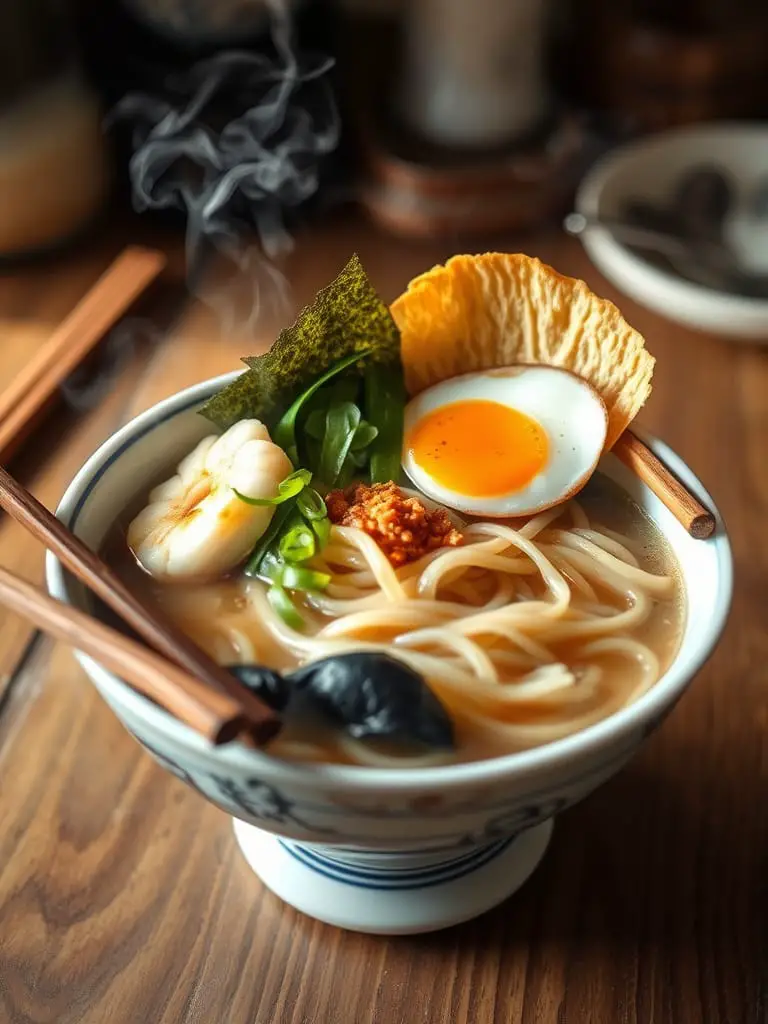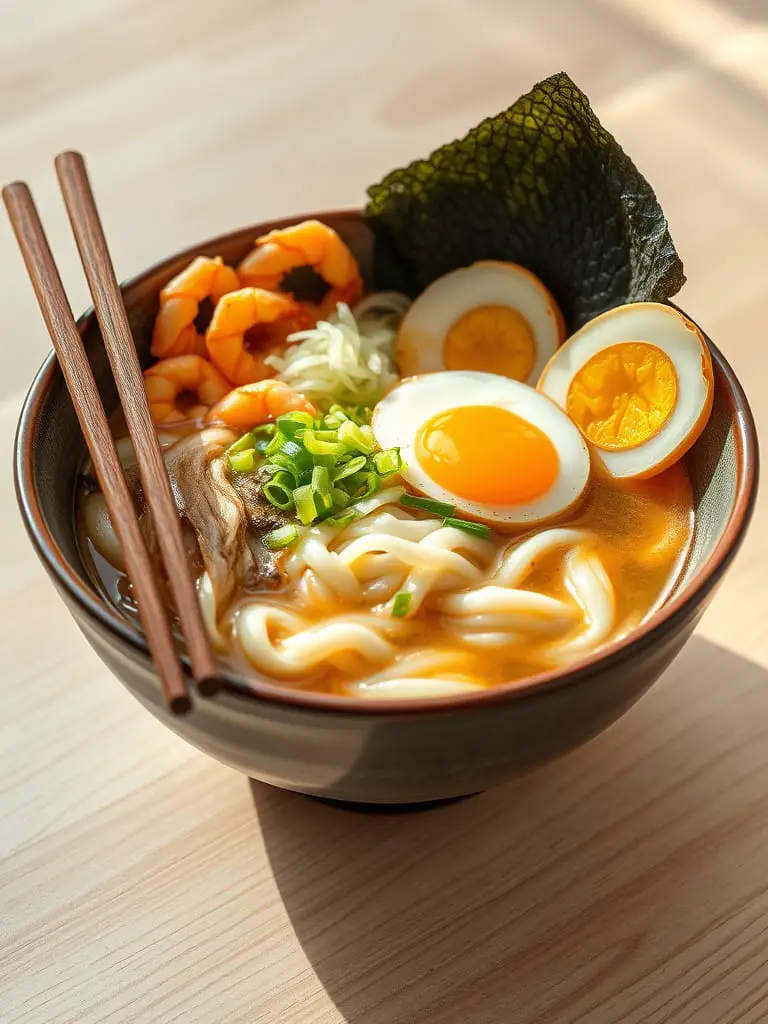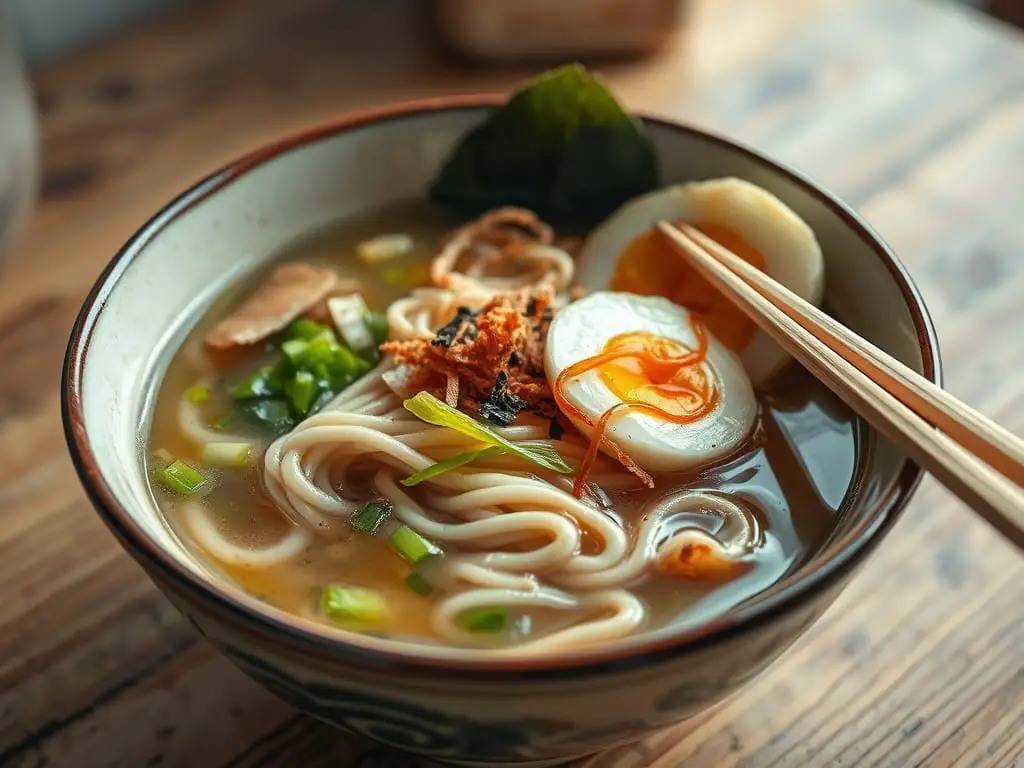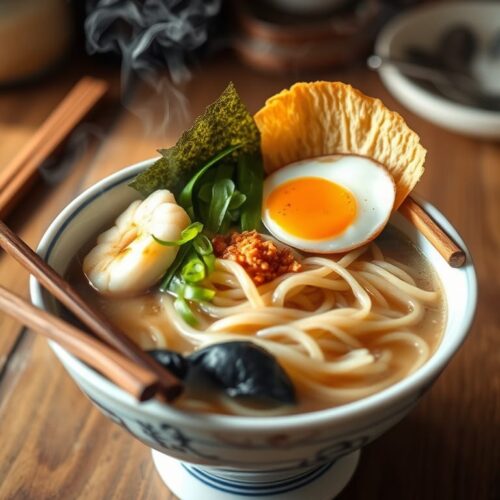The Ultimate Japanese Udon Recipe
There’s something incredibly comforting about a steaming bowl of udon noodles. Whether it’s a chilly winter day or you need a quick, satisfying meal, udon noodles never disappoint. The chewy texture of the noodles combined with a rich dashi broth makes for a meal that’s both hearty and soul-soothing.
This recipe for The Ultimate Japanese Udon is not only authentic but also incredibly easy to make. You’ll be amazed at how a few simple ingredients can come together to create a dish that’s bursting with umami flavors. Plus, it’s a great way to impress your friends and family with a taste of Japan right in your own kitchen.
As an Amazon Associate, I earn from qualifying purchases. This post may contain affiliate links, which means I may receive a commission if you purchase through my links, at no extra cost to you.
Key Ingredients for The Ultimate Japanese Udon
To make this delicious udon, you’ll need a few key ingredients:
- Dried Udon Noodles (8 oz): The star of the show, udon noodles are thick, chewy, and perfect for soaking up the dashi broth.
- Dashi Broth (4 cups): The base of the soup, dashi broth is a traditional Japanese stock made from kombu (kelp) and bonito flakes. You can make it from scratch or use a store-bought version.
- Soy Sauce (1 tbsp): Adds a salty, umami flavor to the broth.
- Mirin (1 tbsp): A sweet rice wine that balances the saltiness of the soy sauce.
- Sake (1 tsp, optional): Another type of rice wine that adds depth to the broth.
- Green Onion (1, thinly sliced): Adds a fresh, sharp flavor and a pop of color.
- Kamaboko (1/2 cup, sliced): A type of fish cake that adds a unique texture and flavor.
- Nori Seaweed (1 sheet, cut into strips): Adds a briny, umami flavor and a bit of crunch.

How to Make The Ultimate Japanese Udon
- Cook the Udon Noodles: Follow the package instructions to cook the udon noodles until they are al dente. Once cooked, drain and rinse them under cold water to prevent sticking.
- Prepare the Broth: In a pot, heat the dashi broth until it’s hot. Add the soy sauce, mirin, and sake (if using), and bring the mixture to a simmer.
- Combine Noodles and Broth: Add the cooked udon noodles to the simmering broth and heat them through until they are warm.
- Serve and Garnish: Ladle the udon and broth into bowls. Garnish with green onions, kamaboko, and nori strips.
- Optional Toppings: For extra flavor and texture, add optional toppings such as tempura, a soft-boiled egg, or a sprinkle of sesame seeds.
Variations
- Vegetarian Udon: Substitute the dashi broth with a vegetable broth and omit the kamaboko. Add tofu or extra vegetables like mushrooms and spinach.
- Spicy Udon: Add a spoonful of chili oil or a dash of red pepper flakes to the broth for a spicy kick.
- Seafood Udon: Add shrimp, scallops, or clams to the broth for a seafood twist.

Pairings
If you enjoyed the comforting broth and noodles of our Udon? Serve it with our Japanese Gyoza for a complete meal.
For a sweet and refreshing drink after your Udon, try our Japanese Matcha Latte Recipe.
Serving Suggestions
Serve your udon in deep bowls to keep the broth warm. A pair of chopsticks and a soup spoon make for the perfect utensils. For a more authentic experience, try serving it with a side of tempura shrimp or vegetables.
Common Mistakes to Avoid
✖ Overcooking the Noodles: Udon noodles should be chewy, not mushy. Follow the package instructions carefully and make sure to rinse them under cold water after cooking.
✖ Skipping the Dashi Broth: The dashi broth is what makes this dish authentic. If you can’t make it from scratch, a good quality store-bought dashi is a must.
✖ Forgetting to Garnish: The garnishes like green onions, kamaboko, and nori add important flavors and textures. Don’t skip them!
Tips and Tricks
✔ Make Dashi from Scratch: If you have time, making dashi broth from scratch can make a big difference in flavor. It’s made by simmering kombu (kelp) and bonito flakes in water.
✔ Prep Toppings Ahead: Slice your green onions, kamaboko, and nori ahead of time so that everything is ready when you need it.
✔ Use Fresh Udon Noodles: If you can find fresh udon noodles, they are even better than dried ones and cook much faster.
✔ Experiment with Toppings: Feel free to get creative with your toppings. Tempura, soft-boiled eggs, and even a bit of grated ginger can add a new dimension to your udon.
Final Thoughts
The Ultimate Japanese Udon is a dish that brings a taste of Japan to your home. It’s a versatile, comforting, and delicious meal that you can make in under an hour. Whether you’re a seasoned cook or a beginner, this recipe is sure to become a favorite.
So, what are you waiting for? Grab your ingredients and start cooking! Don’t forget to share your udon creations with us on social media. We’d love to see how you make this recipe your own. 👇
The Ultimate Japanese Udon Recipe
Ingredients
- 8 oz dried udon noodles
- 4 cups dashi broth store-bought or homemade
- 1 tbsp soy sauce
- 1 tbsp mirin
- 1 tsp sake optional
- 1 green onion thinly sliced
- 1/2 cup kamaboko fish cake, sliced
- 1 sheet nori seaweed cut into strips
- Optional toppings: tempura soft-boiled egg, sesame seeds
Instructions
- Cook udon noodles according to package directions. Drain and rinse under cold water to prevent sticking.
- In a pot, heat dashi broth. Add soy sauce, mirin, and sake (if using). Bring to a simmer.
- Add the cooked udon noodles to the broth and heat through.
- Serve the udon in bowls. Garnish with green onions, kamaboko, and nori strips.
- Add optional toppings like tempura, a soft-boiled egg, or sesame seeds for extra flavor and texture.
Notes
-
- Dashi Broth: You can make dashi broth by simmering a piece of kombu (kelp) and a handful of bonito flakes in water for about 20 minutes. Strain and use as directed.
-
- Storage: Leftover udon can be stored in the refrigerator for up to two days. However, it’s best enjoyed fresh.
-
- Noodle Alternatives: If you can’t find udon noodles, soba noodles can be used as a substitute, although the texture will be different.
Japanese Udon FAQ’s
What is dashi broth made of?
Dashi broth is typically made from kombu (kelp) and bonito flakes (dried, fermented, and smoked skipjack tuna). It’s a staple in Japanese cooking and provides a rich umami flavor.
Can I make this recipe vegetarian?
Yes, you can make a vegetarian version by using a vegetable broth instead of dashi broth and omitting the kamaboko. You can add tofu or extra vegetables like mushrooms and spinach.
What are some other common udon toppings?
Common udon toppings include tempura (shrimp or vegetable), soft-boiled eggs, grated ginger, and even a sprinkle of shichimi togarashi (Japanese seven-spice blend).
🛒 Recommended Kitchen Must-Haves
To make this recipe, you might need a few kitchen essentials such as a good quality pot for making the broth and a colander for draining the noodles.







